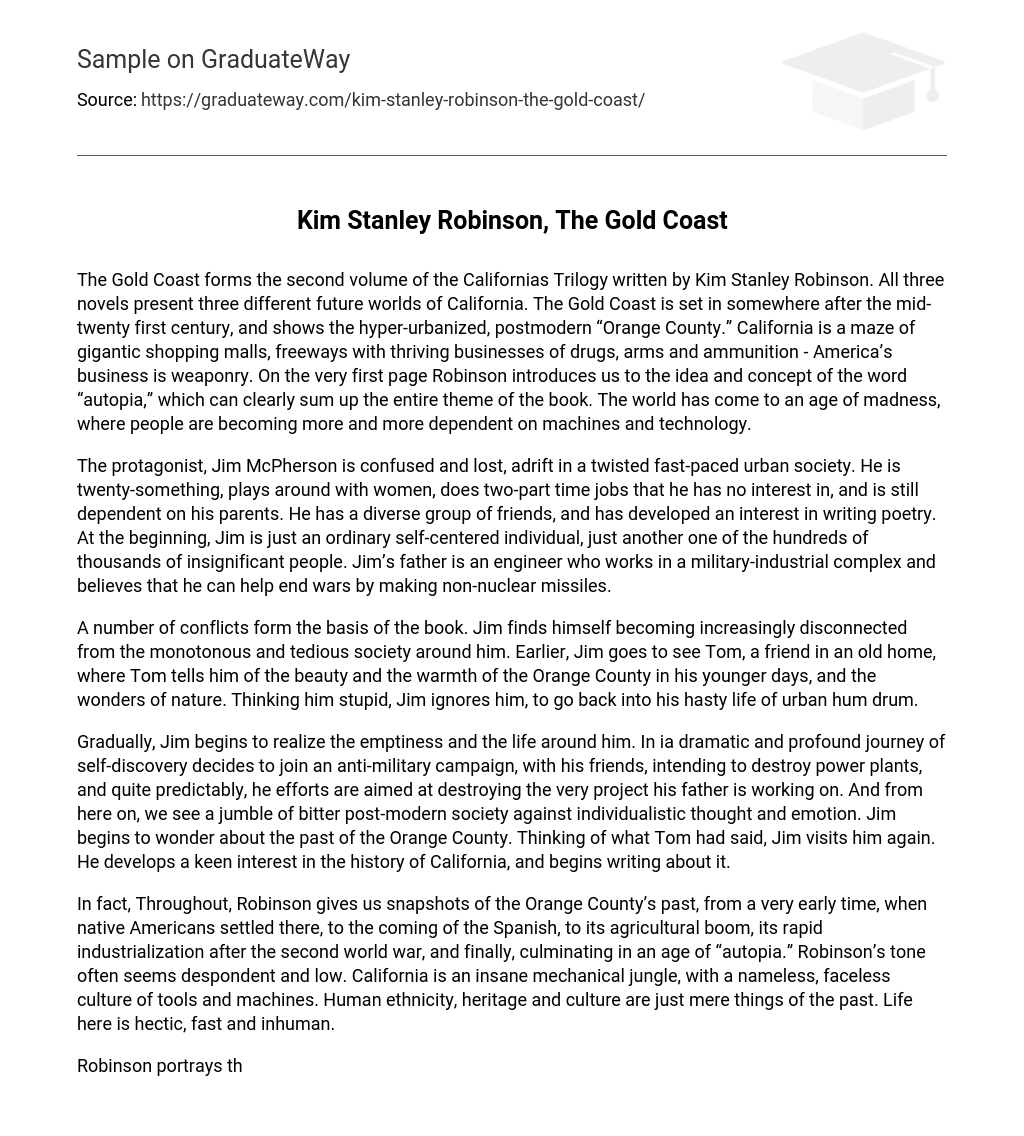The Gold Coast forms the second volume of the Californias Trilogy written by Kim Stanley Robinson. All three novels present three different future worlds of California. The Gold Coast is set in somewhere after the mid-twenty first century, and shows the hyper-urbanized, postmodern “Orange County.” California is a maze of gigantic shopping malls, freeways with thriving businesses of drugs, arms and ammunition – America’s business is weaponry. On the very first page Robinson introduces us to the idea and concept of the word “autopia,” which can clearly sum up the entire theme of the book. The world has come to an age of madness, where people are becoming more and more dependent on machines and technology.
The protagonist, Jim McPherson is confused and lost, adrift in a twisted fast-paced urban society. He is twenty-something, plays around with women, does two-part time jobs that he has no interest in, and is still dependent on his parents. He has a diverse group of friends, and has developed an interest in writing poetry. At the beginning, Jim is just an ordinary self-centered individual, just another one of the hundreds of thousands of insignificant people. Jim’s father is an engineer who works in a military-industrial complex and believes that he can help end wars by making non-nuclear missiles.
A number of conflicts form the basis of the book. Jim finds himself becoming increasingly disconnected from the monotonous and tedious society around him. Earlier, Jim goes to see Tom, a friend in an old home, where Tom tells him of the beauty and the warmth of the Orange County in his younger days, and the wonders of nature. Thinking him stupid, Jim ignores him, to go back into his hasty life of urban hum drum.
Gradually, Jim begins to realize the emptiness and the life around him. In ia dramatic and profound journey of self-discovery decides to join an anti-military campaign, with his friends, intending to destroy power plants, and quite predictably, he efforts are aimed at destroying the very project his father is working on. And from here on, we see a jumble of bitter post-modern society against individualistic thought and emotion. Jim begins to wonder about the past of the Orange County. Thinking of what Tom had said, Jim visits him again. He develops a keen interest in the history of California, and begins writing about it.
In fact, Throughout, Robinson gives us snapshots of the Orange County’s past, from a very early time, when native Americans settled there, to the coming of the Spanish, to its agricultural boom, its rapid industrialization after the second world war, and finally, culminating in an age of “autopia.” Robinson’s tone often seems despondent and low. California is an insane mechanical jungle, with a nameless, faceless culture of tools and machines. Human ethnicity, heritage and culture are just mere things of the past. Life here is hectic, fast and inhuman.
Robinson portrays the characters with great depth and creativity. The book is captivating to read, since it is written in the present tense and Robinson experiments with the narrative in a number of ways. The Gold Coast carries a heavy message of the evils of a postmodern society and mechanization. Written in the late eighties, not surprisingly enough, we can relate to a lot of it quite visibly. It shows a picture of an exhaustive and warped, routine urban society.
The character of Tom is quite typical – the man who is in touch with his inner self. He serves as the connection between the past and the present and shares his wisdom and experiences with the younger generation.
The story though, follows a somewhat typical path of bashing of industrialization and capitalism, which is evident in many works of literature during the era of development and mechanization. Many saw nature and human values and traditions being trampled upon, and being eliminated forever.
Another major under-lying theme of the book is that of an “existential crisis.” Often, we find it difficult to identify ourselves in a world overrun with technology, stress and competition. Individual thought or creation is often ignored. The book follows an intense and remarkable course of self discovery and soul searching. We also get snatches of Jim’s poetry which is quite poignant.
Unlike the first volume of the Californias Trilogy, The Wild Shore, we find it easier to associate ourselves with The Gold Coast. Many parallels can be drawn between Robinson’s depiction of life in the mid-twentieth century, and life today. The twisted post-modern society shown here is quite close to the phase we our going through. The world is in a mad arms race, there is widespread war, famine, drug dealings, terrorists and political maneuvers. Nature is facing extinction, to the extent that today, we are facing an irreversible catastrophe of global warming, because of which we are in danger of losing many precious species of nature.
Undoubtedly, the Californias Trilogy has emerged as a successful comtemporary work about postmodern life. The three novels, The Wild Shore, and Gold Coast and The Pacific Edge all have their own styles and themes, but the most relatable is The Gold Coast, which shows us a picture of life in an over-industrialized America. Crtically speaking, it follows a characteristic path, like other works of postmodern literature, but Robinson does justice to his characters by depicting them in profound depth and insight. They come alive as individual people looking for a purpose or a higher aim in life, realizing that they are much more than what they had been for so long.
Works Cited:
The Gold Coast, by Kim Stanley Robinson ISBN 0-312-89037-0
James Schellenberg, Science Fiction and Fantasy Reviews, http://www.challengingdestiny.com/reviews/goldcoast.htm
Kim Stanley Robinson, The Gold Coast, Amazon Reviews, http://www.amazon.com/Gold-Coast-Kim-Stanley-Robinson/dp/031293050X





